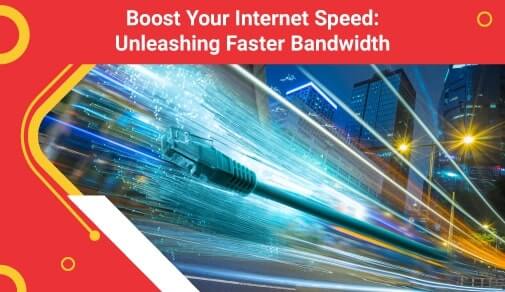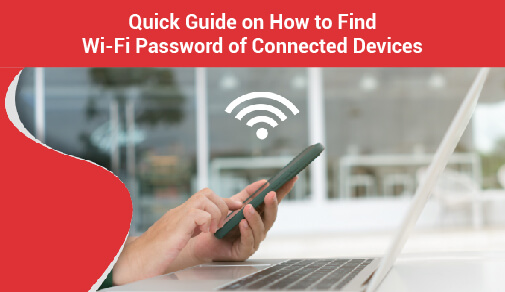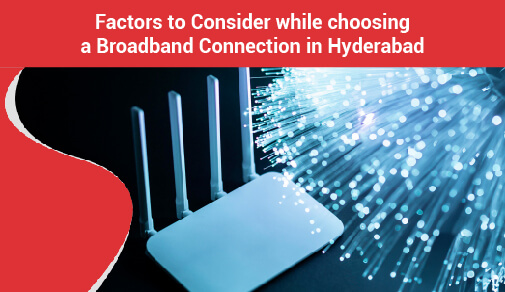Boost Your Internet Speed
-
0
-
-
9 minutes

The internet has become an indispensable part of our lives, with more than five billion users worldwide. This accounts for more than half of the world’s population. As our dependence on the internet continues to grow, it has become crucial to have a fast and reliable connection.
This is where having a high-bandwidth connection becomes important.
Internet bandwidth is the key to having a smooth online experience, as it determines the internet speed. Whether you want to browse, stream videos, or download files, a high-speed internet connection with high bandwidth ensures that all these activities are performed swiftly.
To better understand internet bandwidth and its importance for a seamless online experience, let's delve into details.
Understanding Internet Bandwidth
Bandwidth refers to the amount of data that the internet connection can transmit within a specific time frame. It can also be thought of as the capacity or maximum speed at which data is sent over an internet connection. It is measured in bits per second (bps) or megabits per second (Mbps).
Bandwidth determines how quickly data can be processed by the internet connection. If a user has a higher bandwidth, they can process larger amounts of data quickly and get better performance from their device or web browser.
Let's simplify internet bandwidth further.
Imagine the internet connection as a busy highway. Internet bandwidth represents the number of lanes on this highway, determining the number of vehicles that can travel together at the same time. A higher internet bandwidth means more lanes. Thus, more data can be transmitted in a given amount of time.
When considering internet bandwidth, it is essential for users to understand two terms to better manage their connection — theoretical bandwidth and actual bandwidth.
Theoretical Bandwidth
Theoretical bandwidth is the maximum speed the internet connection can handle under ideal circumstances. In other words, it's the highest possible speed users could get from their Internet Service Provider (ISP) if everything is perfect. This number is usually provided by the ISP and is based on their own internal testing.
Actual Bandwidth
Actual bandwidth, on the other hand, is the rate at which data is actually being transmitted. This number is normally lower than the theoretical bandwidth, as there are many external factors that can affect connection speed.
Thus, users need to take the internet bandwidth speed described by their ISPs with a pinch of salt, as the actual speeds will most likely be lower in real-world usage.
It is important to keep in mind that an individual's internet connection setup, such as the hardware and home environmental factors, usually plays a big role in slowing down the actual speed of the connection than the ISP being at fault.
Understanding Internet Speed
Most people get confused between internet bandwidth and internet speed, as both these terms are often used interchangeably. While these terms are related, they are not the same. We have already looked at internet bandwidth. Now let's look at internet speed now.
Internet speed is a measure of how quickly data can be transferred from one device to another across the network in a given time period. The transfer rate, or speed, is usually measured in Mbps.
Considering the example discussed earlier, internet speed could be seen as the number of vehicles that can actually travel on the highway in a given time. With greater bandwidth (more lanes), more cars can travel at the same time, thus achieving higher speed, and vice versa.
The internet speed can never be greater than the allocated internet bandwidth — the number of lanes determines the number of cars that can move at once. Thus, to have a high-speed internet connection, it is important to ensure that the allocated bandwidth is high.
Factors Affecting Internet Bandwidth Speeds
As mentioned earlier, the actual bandwidth speeds experienced by a user can vary significantly from the advertised speed due to a number of factors. Some of these include:
Type of Internet Connection
One of the most critical factors affecting internet speed is the type of connection. Different types of internet connections (e.g., DSL, Cable, Fiber internet) or (Wired and Wireless) are designed to provide different speeds and performance levels.
Fiber internet connection is considered to be the fastest. It offers bandwidths ranging from 100 Mbps to over 1 Gbps. Cable and DSL connections provide much slower speeds. Thus, users should always opt for fiber internet connections to maximize their internet bandwidth speeds.
Further reading: DSL vs. Cable vs. Fiber Internet
Similarly, wired connections offer higher speeds than wireless connections. This is because they don't share the internet bandwidth with multiple devices and are not affected by interference.
Network Congestion
Network congestion is another factor that affects internet speeds. During peak hours, the large amount of traffic in a network causes latency and slows down the connection as it takes time for information to be transmitted between different networks.
Similarly, network congestion can also be caused if numerous users are simultaneously downloading or streaming large files on the same network. This can also cause latency and slow down the connection speed significantly.
Type of Data Transmitted
The type of data transmitted also affects the speed of the internet connection. Video files, for example, require more bandwidth than text files and can generally take longer to download or stream.
Plus, high-resolution images and videos may take even longer to download due to their large file sizes. It is best to choose lower-resolution versions if users want faster internet speeds.
Network Protocol Used
The network protocol used also plays a role in determining the speed of the connection. Different internet protocols use different techniques to transmit data, and some can be faster than others.
The two most common protocols are Transmission Control Protocol (TCP) and User Datagram Protocol (UDP). TCP is generally more reliable but slower, while UDP is usually faster but less reliable. It is vital to choose an appropriate protocol for the type of data to be transmitted.
Environmental Factors
Finally, environmental factors such as terrain, weather, and distance can affect the speed of the connection. For example, if the user is in a rural area with poor signal strength or if they are far from an ISP's servers, their available bandwidth could be less than normal.
It is also crucial to consider other external factors that may affect the connection speed. This includes the number of people on the network, the type of equipment used, and even the programs and applications running in the background. Users may want to disable any unnecessary programs or applications to help improve their connection speed.
Tips To Enhance Internet Bandwidth Speed
Now that we have looked at the causes of limited internet bandwidth, let’s go through some tips on how to speed up Wi-Fi, which can lead to a faster internet experience:
Optimizing Router Placement
One of the easiest ways to enhance internet speed is to optimize router placement. Place the router in an open space and avoid putting it behind walls, furniture, or any objects that may interfere with the signal strength. Elevating the router can also improve signal propagation, maximizing coverage across the space.
Investing in High-Quality Equipment
Upgrading to high-quality routers and modems can be a game-changer for faster internet speed. Advanced equipment supports the latest Wi-Fi standards, enhancing data transfer rates and overall network performance. Consider buying routers with built-in features such as MU-MIMO, beamforming, and QoS.
Minimizing Interferences
Interferences can have a negative effect on the overall internet speed. Common sources of interference are microwaves, cordless phones, and baby monitors. If possible, avoid placing these devices near the router or moving them to another frequency channel. Also, try not to use too many devices connected to the same network at once, as this can slow down speeds significantly.
Updating Software & Firmware
Users need to update their router’s firmware and software regularly, as these updates often include new features that can significantly improve internet performance. Moreover, updating the devices' operating systems (routers, computers, and mobile devices) will remove any potential security issues or glitches and ensure a high-speed connection.
Upgrading The Internet Service Provider
Sometimes, the best way to get a more reliable connection with high bandwidth is to switch to a different ISP. While optimizing the current setup can yield improvements, there are instances when the limitations of the current ISP might hinder the pursuit of seamless online experiences. This is where exploring alternative ISPs, such as ACT Fibernet, comes into play.
ACT Fibernet offers a high-speed internet connection delivered by fiber-optic cables, making it possible to achieve the best browsing experience. Plus, our expert technical team provides installation, troubleshooting, and support services to ensure that the connection is always running optimally.
This way, users can enjoy a secure and reliable network without any interruptions or hiccups. Ultimately, switching to ACT Fibernet will not only resolve existing speed issues but also provide a better connection for future online activities.
How To Check The Internet Speed
To make sure that they are getting the best value from their ISP, users should use an internet speed test to gauge the performance of their connection. This can be done through services such as Speedtest.net or Fast.com (both are free and reliable).
By testing the speed of download/upload speeds, latency, packet loss rate, and jitter rate, it is possible to determine whether the connection is running optimally or not. Let us explain each of these parameters in detail:
Download/Upload Speed: This is the most common indicator of internet speed, and it is measured in Mbps, or gigabits per second (Gbps). This parameter indicates how quickly a user can transfer data from one point to another over the network.
Latency: It is also known as ‘ping’ and is measured in milliseconds (ms). It indicates the amount of time it takes for data to travel from one point to another. Low latency is desirable, as it indicates a faster speed.
Packet Loss Rate: This parameter measures the percentage of packets that are lost during transmission over the network. Lost packets can slow down internet speed significantly, so it is important to keep this number low.
Jitter: It is the variation in latency between packets over a period of time and is measured in ms. High jitter can cause data loss as packets arrive out of order or are dropped. Keeping jitter low will ensure the efficient transfer of data.
Further reading: Beginner's Guide to Internet Speeds
By having a good understanding of these terms, users can troubleshoot internet connection problems and ensure that they get the best possible speeds. This will help in providing smooth and reliable internet access for an optimal user experience.
Wrapping Up
In a world where the internet has become an integral part of daily life, having a fast and reliable connection is paramount. Internet bandwidth plays a crucial role in determining the speed and efficiency of online activities, whether it's browsing, streaming, or downloading.
ACT Fibernet is one of the leading internet service providers in India and offers a variety of high-speed internet plans with fair pricing. With its easy installation and quality service, it provides a great way to get connected quickly and enjoy an uninterrupted and high-speed internet experience. Contact us today to join our network and start enjoying the power of a reliable, high-bandwidth internet connection!







